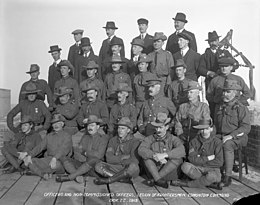This is an old revision of this page, as edited by MarqFJA87 (talk | contribs) at 14:05, 9 December 2024 (→Military organizations). The present address (URL) is a permanent link to this revision, which may differ significantly from the current revision.
Revision as of 14:05, 9 December 2024 by MarqFJA87 (talk | contribs) (→Military organizations)(diff) ← Previous revision | Latest revision (diff) | Newer revision → (diff) Organization similar to, but not part of, a military Not to be confused with Paratrooper or Private army.| This article needs additional citations for verification. Please help improve this article by adding citations to reliable sources. Unsourced material may be challenged and removed. Find sources: "Paramilitary" – news · newspapers · books · scholar · JSTOR (October 2022) (Learn how and when to remove this message) |

A paramilitary is a military that is not a part of a country's official or legitimate armed forces. The Oxford English Dictionary traces the use of the term "paramilitary" as far back as 1934.
Overview
Though a paramilitary is, by definition, not a military, it is usually equivalent to a light infantry or special forces in terms of strength, firepower, and organizational structure. Paramilitaries use combat-capable kit/equipment (such as internal security/SWAT vehicles), or even actual military equipment (such as long guns and armored personnel carriers; usually military surplus resources), skills (such as battlefield medicine and bomb disposal), and tactics (such as urban warfare and close-quarters combat) that are compatible with their purpose, often combining them with skills from other relevant fields such as law enforcement, coast guard, or search and rescue. A paramilitary may fall under the command of a military, train alongside them, or have permission to use their resources, despite not actually being part of them.
Legality
Under the law of war, a state may incorporate a paramilitary organization or armed agency (such as a law enforcement agency or a private volunteer militia) into its combatant armed forces. Some countries' constitutions prohibit paramilitary organizations outside government use.
Types

Depending on the definition adopted, "paramilitaries" may include:
Military organizations
- The auxiliary forces of a state's military or government, military reserve forces, such as national guard, presidential guard, republican guard, state defense force, home guard, civil guard, imperial guard, and royal guard forces
- Private military contractors and mercenaries
- Irregular military forces, such as militias, partisans, resistance movements, freedom fighters, rebel groups, liberation armies, guerrilla armies, militants, insurgents, and terrorist groups.
Law enforcement
- Semi-militarized law enforcement units within civilian police, such as police tactical units, SWAT, Emergency Service Units, and incident response teams
- Gendarmeries, such as the French National Gendarmerie, Dutch Royal Marechaussee, Egyptian Central Security Forces, European EUROGENDFOR, Turkic TAKM, and Chilean Carabineros de Chile
- Border guards, such as the Australian Border Force, Indian Border Security Force, Bangladeshi Border Guard Bangladesh, and Turkish village guards
- Security forces of ambiguous military status, such as internal troops, railroad guard corps, and railway troops
- Branches of government agencies such as intelligence agencies tasked with law enforcement, tactical support, or security operations, such as the Central Intelligence Agency's Special Activities Center and Global Response Staff, or the U.S. Department of Energy's Federal Protective Forces
Civil defense
Political
- Armed, semi-militarized wings of political parties and similar political organizations.
Examples of paramilitary units
For a more comprehensive list, see List of paramilitary organizations and List of defunct paramilitary organizations.See also
- Category:Rebel militia groups
- International Association of Gendarmeries and Police Forces with Military Status
- List of Serbian paramilitary formations
- Militarization of police
- Police tactical unit
- Fourth-generation warfare
- Violent non-state actor
- Military urbanism
- Private army
- Fascist paramilitary
- Guerrilla warfare
- List of countries by number of military and paramilitary personnel
- List of paramilitary organizations
- Bangladesh Ansar
- Border Security Force
References
- "paramilitary". Oxford English Dictionary (3rd ed.). Oxford University Press. June 2011 . Retrieved 2011-09-13.
Designating, of, or relating to a force or unit whose function and organization are analogous or ancillary to those of a professional military force, but which is not regarded as having professional or legitimate status.
- "paramilitary". Oxford English Dictionary (Online ed.). Oxford University Press. (Subscription or participating institution membership required.)
- "Wider conflict feared as Sudan's army and rival paramilitary force clash in capital". PBS NewsHour. 2023-04-15. Retrieved 2023-07-28.
- ^ Böhmelt, Tobias; Clayton, Govinda (February 2018). "Auxiliary Force Structure: Paramilitary Forces and Progovernment Militias". Comparative Political Studies. 51 (2): 197–237. doi:10.1177/0010414017699204. hdl:10654/38817. ISSN 0010-4140.
Further reading
- Golkar, Saeid. (2012) Paramilitarization of the Economy: the Case of Iran's Basij Militia, Armed Forces & Society, Vol. 38, No. 4
- Golkar, Saeid. (2012). Organization of the Oppressed or Organization for Oppressing: Analysing the Role of the Basij Militia of Iran. Politics, Religion & Ideology, Dec., 37–41. doi:10.1080/21567689.2012.725661
- Üngör, Uğur Ümit (2020). Paramilitarism: Mass Violence in the Shadow of the State. Oxford University Press. ISBN 978-0-19-882524-1.